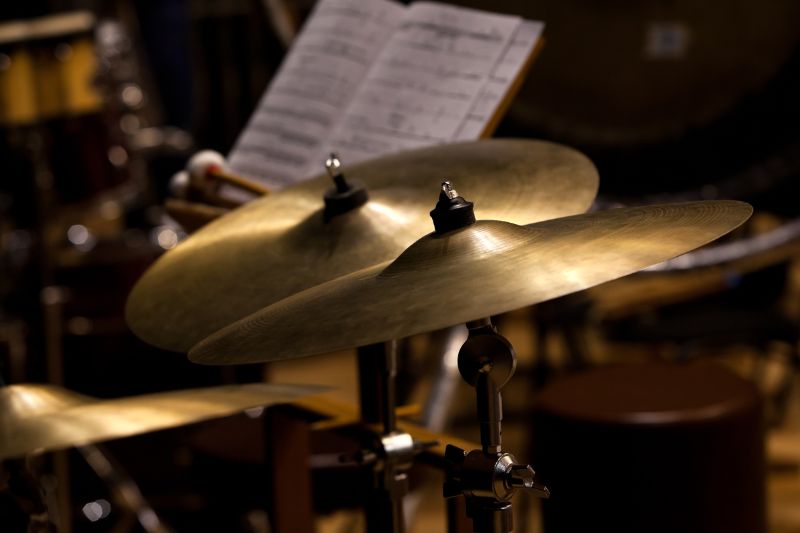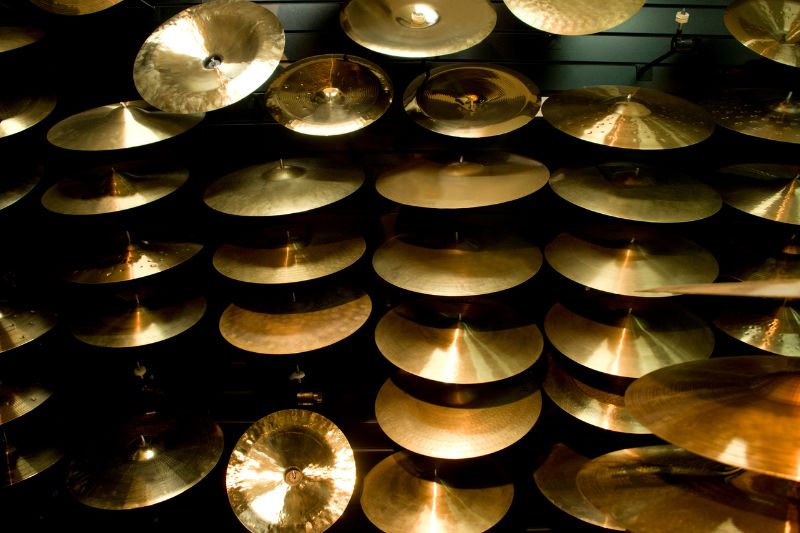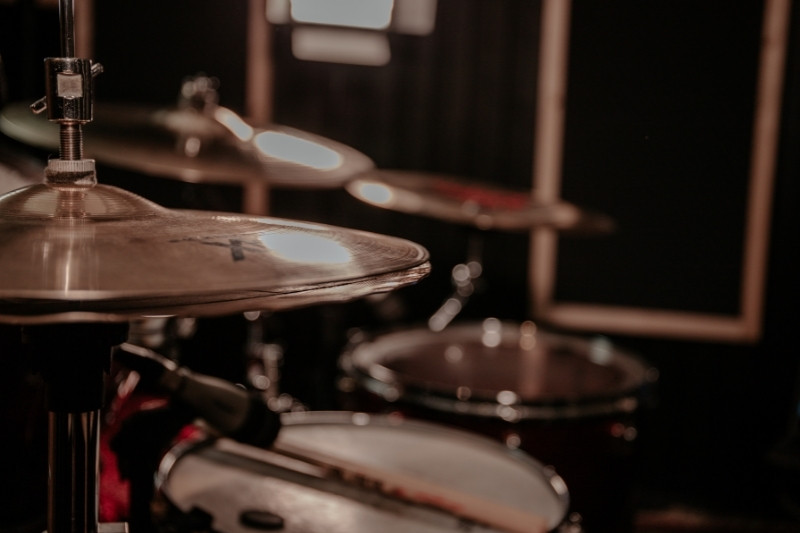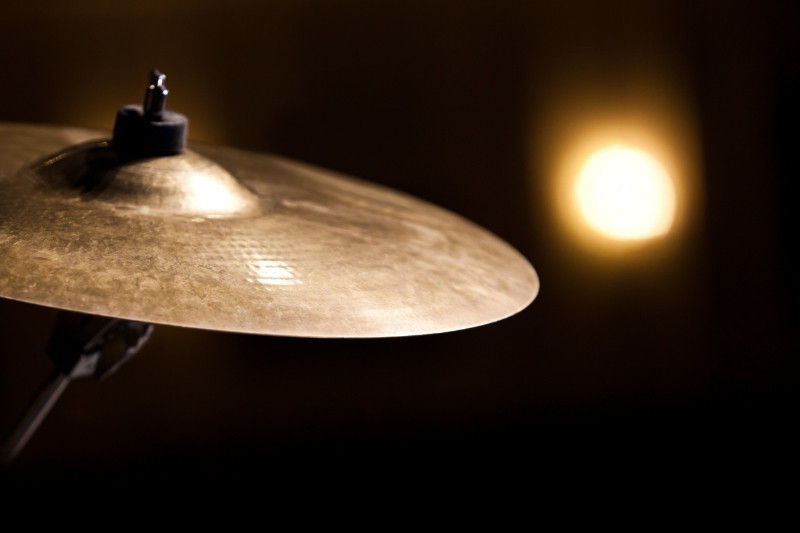The Ultimate Guide to the 10 Types of Cymbals
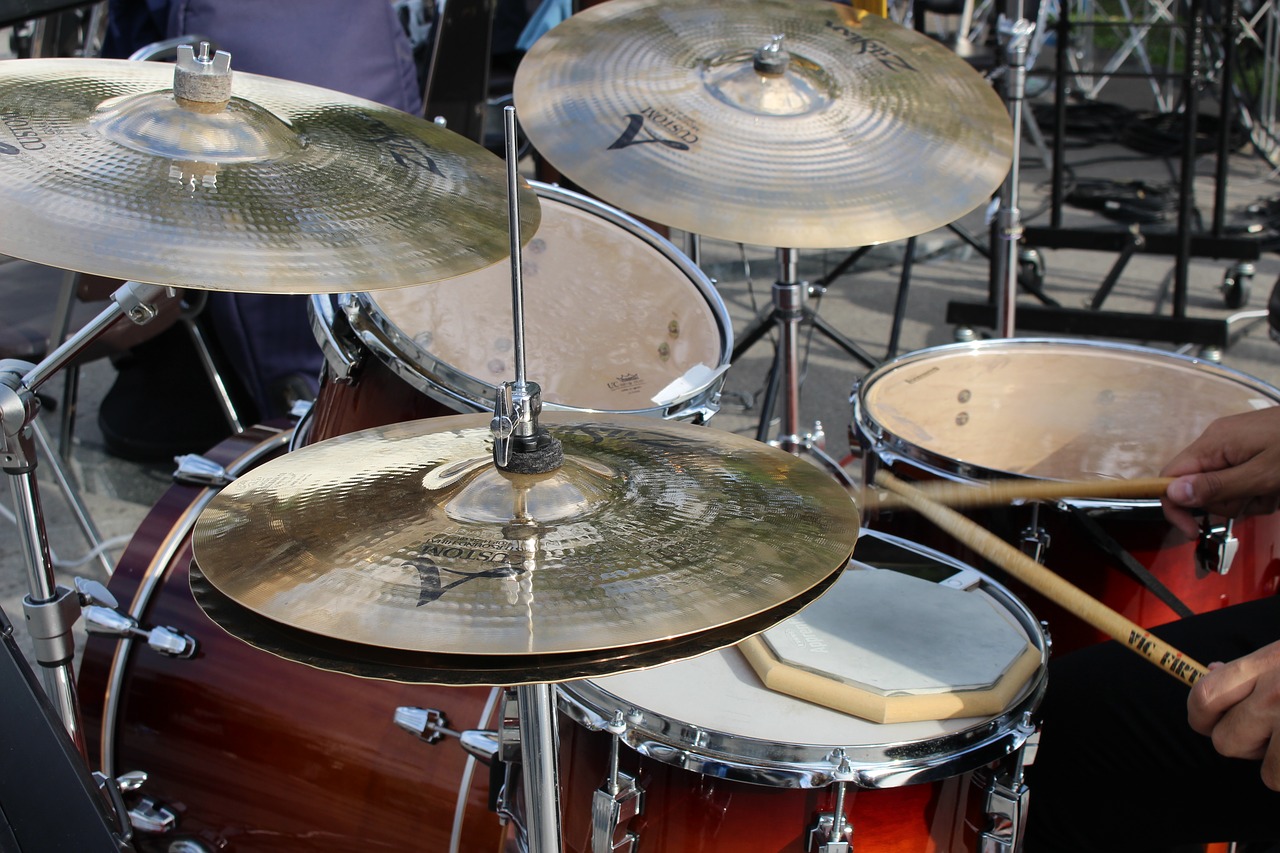
Cymbals are an essential part of any drummer’s kit. They help shape your drum beats and set the musical mood. Great cymbals help make sure that your music has a richness to it that makes listeners fall in love with it.
That said, when you start looking to fill out your drum set, you can find a variety of different cymbal types available on the market.
On drum sets, the following cymbals are the most common:
- Crash Cymbal
- Hi-Hats
- Ride Cymbals
Every drum set includes a hi-hat. Most beginner drum sets also include a ride and at least one crash cymbal. For cheaper sets, there may be a single cymbal that acts as both a ride and a crash cymbal (called a ‘ride-crash’ cymbal).
However, there are a lot of other options available. For those wondering where to get started, here are some of the major cymbal types:
Contents
1. Crash Cymbals

- What does a crash sound like? It produces a loud crashing sound.
- Used for: Added accents and expression to the music
- Sizes: Usually between 14 to 18 inches (35cm to 45cm), but they can come in different sizes
- How to hit a crash cymbal: You hit them strongly across the side of the cymbal with the shoulder or shaft of the stick (don’t hit them straight on, as it can reduce the life of the cymbal)
These are loud and explosive instruments – if you think about what a cymbal should sound like, this is probably the type of cymbal that you’re imagining.
Along with ride cymbals, they are among the most common type of cymbals used by drummers and are used as an accent – like their name, they produce a loud “crash” sound when played, adding expression to your music.
They are available in a variety of thicknesses – thinner crash cymbals produce brighter sounds.
The history of the crash cymbal is a long one and can be traced to ancient China. These cymbals are thought to be one of the oldest instruments that are still used today.
In a standard drum set, you usually find one or two crash cymbals. Unlike many other cymbals.
To ensure a crisp sound, you should make sure to clean your crash cymbals regularly – the cleaner they are, the crisper the sound they produce.
For further reference and options for buying, check out the best crash cymbals available today.
2. Ride Cymbals
- What does a ride cymbal sound like? It can produce crisp sounds with long sustain, or deep swelling sounds.
- Used for: Playing steady patterns with your strongest hand.
- Sizes: Usually around 20 inches (51 cm) (but sizes can vary).
- How to play them: They can be in played numerous ways. Use the tip of your drumstick across the surface of the top of the ride cymbal. Hitting the edge of the cymbal with the shoulder of your drumstick.
Hitting the bell (the inside part of the ride cymbal) with the shaft or shoulder of the drumstick.
Usually the largest cymbal in a drum kit, these are most often used to play steady patterns.
Though they sound similar to hi-hats, the biggest difference between them is that rides cannot produce the open and close sound that is so unique to hi-hats.
The bell of the cymbal makes a sharp, bell-like sound, with a low sustain. On the other hand, playing the bow creates a sound that is subtler, and the sound the cymbal creates is far more familiar to a listener’s ear.
If you’re looking to buy a good ride cymbal, then take a look at the best ride cymbals on the market today.
3. Hi-Hats
- What does a hi-hat sound like? When the hi-hats are closed it creates a very tight sound. If the hi-hats are looser together, it creates a much more trashy and sizzling sound when they are struck.
- Used for: Playing steady patterns.
- Sizes: Usually around 14 inches (but they can be slightly bigger or smaller).
Hi-hats are a set of two cymbals that sit together on a stand. They are designed to bring the top cymbal (or ‘hat’) down on the bottom one with the help of a foot pedal.
Along with ride cymbals, these serve as time-keeping cymbals and can be played either with the help of the foot pedal or with drumsticks.
Check out the best hi-hat cymbals for further reference.
Hi-hats are often played when a drummer is looking to create steady patterns – playing them while they are open provides you with a sandy, sizzle sound that serves as an additional accent for your music. Varying the gap between the two cymbals allows you to change the sound and create a much more
When closed, they produce a more varied sound. This varied sound can be everything from one that is short and crisp to a far more aggressive sound that is muted and metallic – it is all dependent on the type of the cymbals.
Hi-hats usually vary between 12” and 16” in size, though the size doesn’t usually matter. Modern hi-hats tend towards a heavier weight, usually weighing more than crash cymbals. Drummers often choose hi-hat cymbal sizes based on their preferences.
4. Splash Cymbals
Though they are, in many ways, similar to crash cymbals, splash cymbals help provide your riffs and solos with accents and also come in handy when you’re looking to create special drumming effects.
These cymbals tend to be smaller in diameter, and are thin cymbals that are hit hard to create a quick attack and decay.
The design of splash cymbals allows them to create a sound that is sharp and short, one that can resemble a splash of water.
It allows drummers to add personality and flair to their music without clashing with the frequency of other instruments and elements of the drum kit.
These are usually the smallest of the different types of cymbals and usually range in size from 6” to about 13”, though they can be as small as 4”.
Whether you’re looking for a beginner splash or a pro pick, you will find more reference for the best splash cymbals available in our other article.
5. China Cymbals (or Chinese Cymbal)
Named for their similarities to Chinese gongs, both in look and sound, these cymbals are easily recognizable because of their upturned edges and cylindrical bell.
When it comes to thickness, most china cymbals have little to no taper. The sound they create is dark and trashy.
It can also sound explosive and crash-like when played. Due to this distinctive sound, they are also often called trash cymbals.
When it comes to playing them, they are usually played in a manner that is similar to crash or ride cymbals.
They are most commonly used in rock music, jazz fusion, and Latin.
The thing that truly defines china cymbals is their ‘trashy’ sound – they vary vastly in size, and can be found in sizes from 8” up to much larger, 27” models.
If you’re looking for an amazing-sounding china cymbal, then take a look at the best china cymbals on the market now.
6. Effects Cymbals
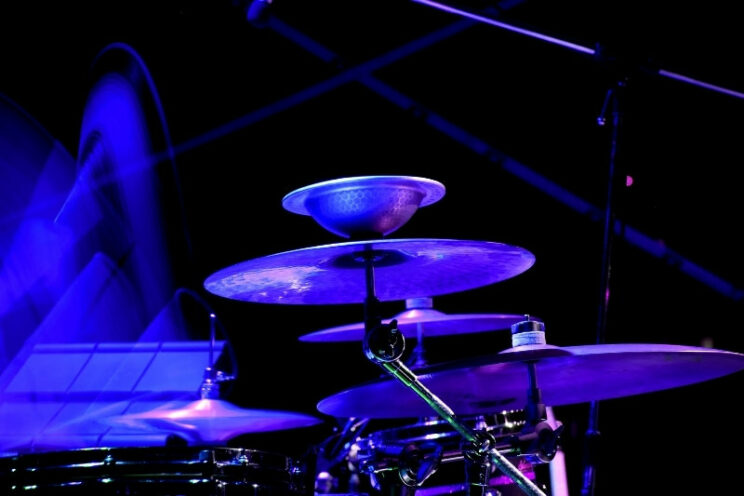
The term ‘effects cymbals’ can be applied to a wide variety of cymbals, and there is no strict definition of the type of cymbals it can encompass.
This term can be used to refer to everything from large, oddly shaped sheets of metal that are used as cymbals to tiny splash cymbals to cymbals that have riveted jingles that help create a more unique sound.
Usually, they’re used in non-rhythmic ways that provide your drumming with accents and tonal color in bursts.
They often have holes in the cymbals that help create a trashy, or particularly unique, sound. You can play these cymbals in any number of ways, including crash, ride, or splash cymbals.
Effects cymbals encompass a large variety of cymbals, therefore they do not have any set or general size.
7. Swish Cymbals
They are effectively exotic ride cymbals or china cymbals. They have a more unique sound, with holes and rivets around the end of the bow. Swish cymbals vary from 16” to 22” in size.
If you have a cymbal with minor cracks, you can create a cymbal similar to a swish by inserting holes and rivets. Drilling holes in your cymbals at the point of your cracks can considerably extend the life of the cymbal. However, keep in mind that it will certainly change the sound of your cymbal.
8. Cymbal Stacks
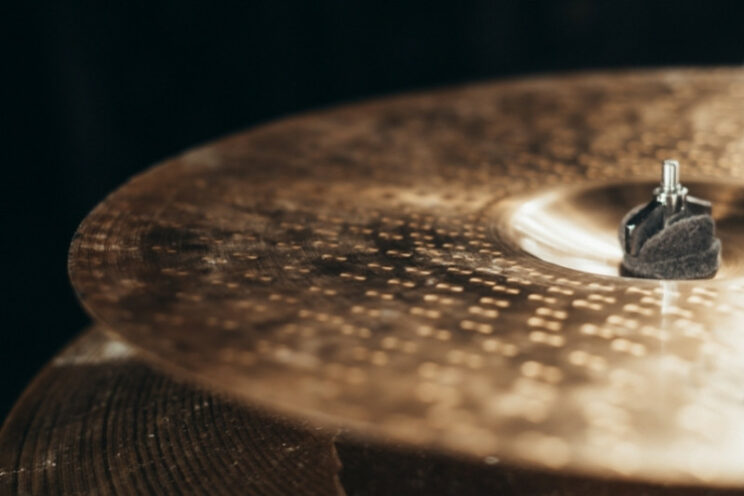
Cymbal stacks are exactly what they sound like – several cymbals, two or more, that are stacked one on top of another. When you hit a single cymbal, they start a chain reaction – essentially, hitting one cymbal results in them hitting each other.
This means that whatever each cymbal originally sounded like, the combination of the cymbals in a stack results in a completely changed sound. It is often a gritty, trashy sound that results from a cymbal stack, and stacks are most often used to get tight, trashy, bright sounds that cut through the rest of the sound you are creating.
You can create your own, unique stack, or buy pre-made ones. Given the way stack cymbals are formed, there is no “accepted” size for the cymbals you use in a stack. Any size and combination of cymbals can work, and each combination will result in its own, unique sound.
Should you buy a cymbal stack or create your own? In our opinion, if you find yourself cracking cymbals, then creating a stack out of them is a great way to get great use out of them. You could also pick up some used cracked cymbals for very cheap and stack them together.
Alternatively, there are plenty of interesting cymbal stacks that you can buy.
9. Orchestral Cymbals
Orchestras use two types of cymbals, hand cymbals, and suspended cymbals. Let’s go more in-depth for each.
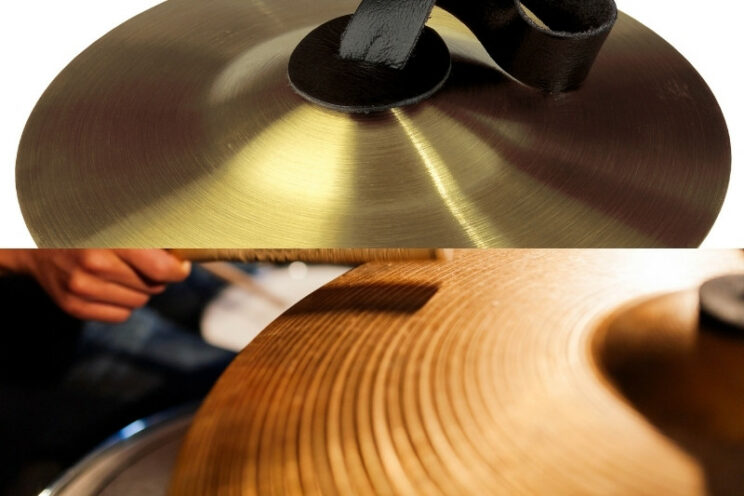
Orchestral Hand Cymbals
Otherwise known as clash cymbals or concert cymbals, orchestral cymbals are usually played in matched pairs.
They are struck against each other – each cymbal is held in an individual hand and then struck together to produce a sound.
The smallest orchestral cymbals have the highest pitch, while the thinner ones have the greatest expression, and the largest ones have the greatest volume. These cymbals are most often used in marching bands, orchestras (hence the name), military bands, percussion ensembles, and theatrical performances.
Suspended Cymbals
These are so named because the cymbals are suspended from a leather strap or rope. This lets the cymbals vibrate as freely as possible, and creates the maximum possible musical effect.
Technically, cymbals on drum sets are suspended cymbals, but the term is far more often used for orchestral cymbals.
10. Other types of Cymbals
Many other types of cymbals can be found in different parts of the world. We’re not going to go through an extensive list of them, but out of interest, here are two other popular types of alternative cymbals:
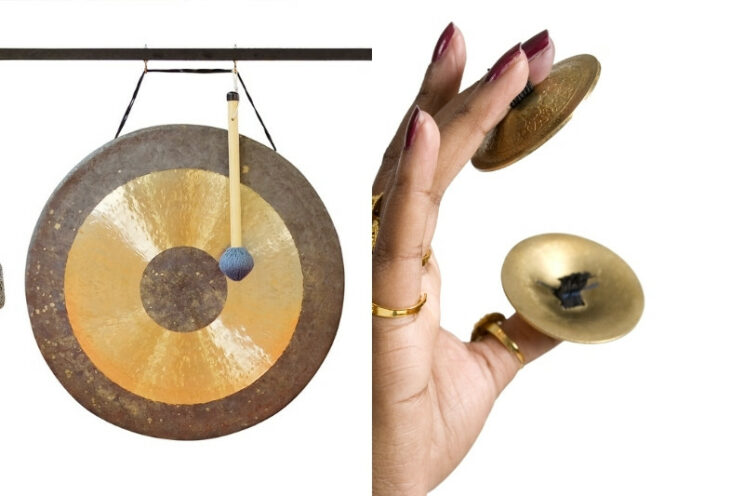
Gongs
These are circular and flat metal discs that create a sound by being hit with a mallet. There are two major types of gongs: ones with a much flatter surface that creates a ‘crash’ sound, and bossed gongs, which have a raised central boss (or knob), that create a more tuned sound, and are usually played either suspended or horizontally.
Finger Cymbals
Otherwise known as zills, after the Turkish name for them, these small cymbals are usually used in belly dancing and other similar performances. They are usually used in a set of four cymbals, two per hand.
They come in a variety of sizes, each of which produces a different kind of sound, and each is meant for a different kind of performance. Belly dancers, for example, use finger cymbals that produce a more delicate sound, while a performer with an orchestra will usually use a larger one that will also have a greater volume.
Summary
That’s our guide to the different types of cymbals that you can find. If you’re playing on the drum set, then be sure to master the important ones first.
The hi-hat, ride, and crash are by far the most important cymbals. Later on, you can focus on the other types. Each drummer ultimately creates their own drum kit, choosing the type of cymbals that work best for the type of music and sound they are looking to create.
If you don’t currently own a set of cymbals, make sure to check to the guides on this site to give you some guidance on the recommended options. Alternatively, if you have a drum store near you then get a drumstick and try out as many of them as you can see!
Enjoy your journey of trying out different cymbals. They can really craft and sculpt the sound of your drum set.

